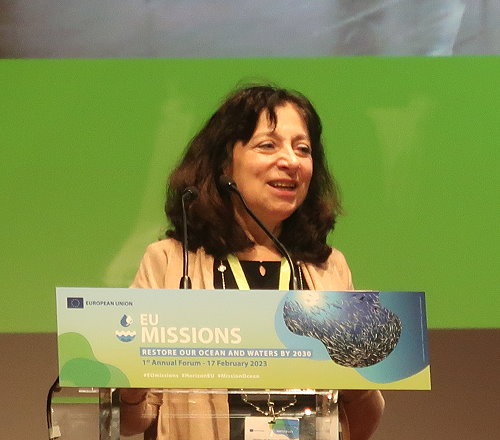 This was the first flagship event of the Mission to restore the ocean and waters, a major European initiative to prevent pollution, protect biodiversity and develop sustainable activities in our ocean and waters by 2030. Forum attendees had the opportunity to get some impressions of the first year of implementation of the Mission, showcasing an initial portfolio of projects and actions to achieve the Mission’s objectives. The full day of plenty of short presentations was interrupted by rather long breaks to allow for discussions and networking. Mundus maris shares some impressions.
This was the first flagship event of the Mission to restore the ocean and waters, a major European initiative to prevent pollution, protect biodiversity and develop sustainable activities in our ocean and waters by 2030. Forum attendees had the opportunity to get some impressions of the first year of implementation of the Mission, showcasing an initial portfolio of projects and actions to achieve the Mission’s objectives. The full day of plenty of short presentations was interrupted by rather long breaks to allow for discussions and networking. Mundus maris shares some impressions.
During the opening remarks Virginijus Sinkevičius, Member of the European Commission for Environment, Oceans and Fisheries, connected from Ukraine, said 'This Mission is urgent. Preserving and restoring the health of our ocean and waters is about preserving our life and all life on this planet. It is by joining our efforts that we will regenerate marine habitats, bring back fish populations, and make our blue economy more sustainable. Thanks to EU-funded projects, research, citizen activism and the growing number of organisations, we are on our way to achieving this critical Mission.'
It fell to Charlina Vitcheva, Director-General, DG Maritime Affairs and Fisheries (see inset photo above), to recall that the Mission, officially announced in September 2021, supports regional engagement and cooperation through area-based “Lighthouses” in major sea and river basins: Atlantic-Arctic, Mediterranean Sea, Baltic-North Sea, and Danube-Black Sea. Mission lighthouses are sites to pilot, demonstrate, develop and deploy the Mission's restoration activities across EU seas and river basins. A 'tidal wave of money' mobilised through a range of mechanisms from Horizon Europe (research), loans from the European Investment Bank, regional funds and more are intended to make good on earlier weak attention to the ocean. Among the thematic focal areas are the energy transition and improved fisheries management engaging also neighbouring countries. The ambition is to focus everybody's mind on the urgent need to restore the ocean and inland waters to good health again. She enthusiastically called for citizen engagement to fill the restoration ambition with life, but unfortunately did not mention concrete measures that are overdue, such as reducing the worst forms of bottom trawling.
This appeal to broader engagement and setting high ambitions will be shortly presented in public in the new strategy paper and was preceded by a lovely performance. It reminded all participants that the ocean and waters are not only expressed in statistical numbers, but in the air we breathe, in the fish we eat, in human cultures and emotions. A good reminder to engage minds, bodies and hearts in the restoration challenge to 2030.
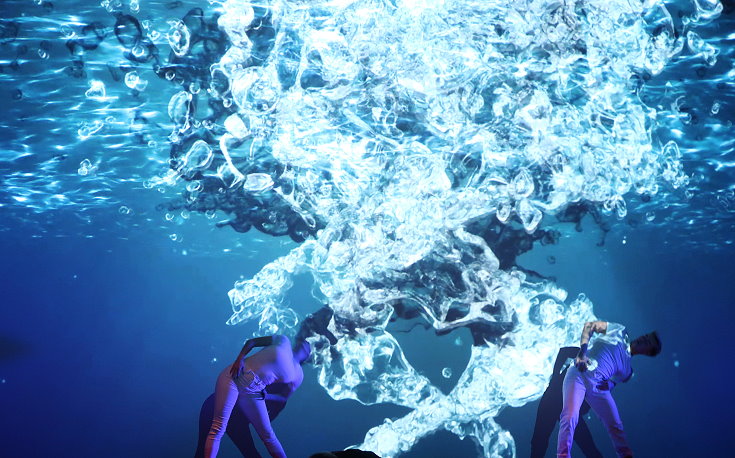

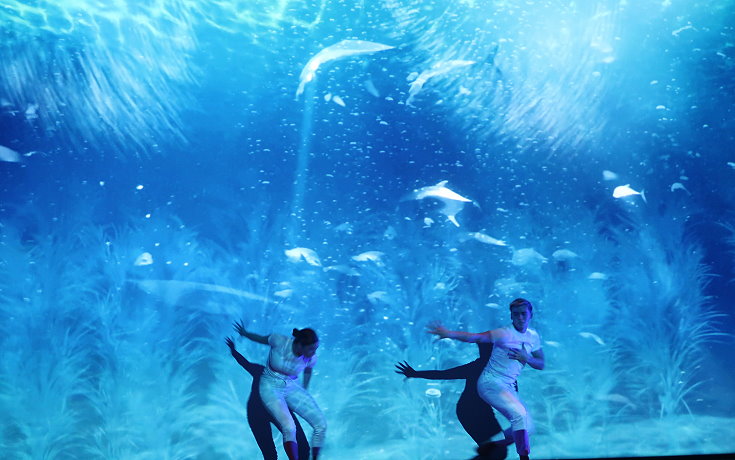
Research and innovation are a major component of the mission feeding into all geographic and thematic components. The day before the gathering the Commission announced funding for 20 new projects under the Horizon Europe Programme in a wide range of areas, most with some potential contribution to the mission.
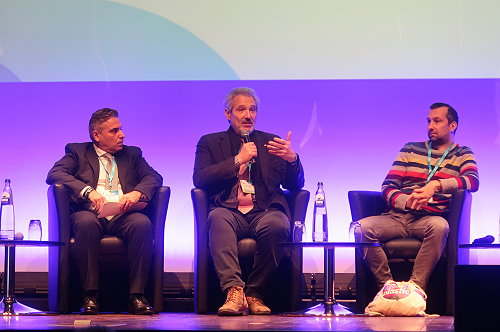 REMEDIES is one of these projects focused on the reduction of water pollution through plastics. Uroš Novak of the Kemijski Institute in Slovenia (to the right on the photo) is the coordinator and was also one of the speakers at the forum in the Mediterranean panel.
REMEDIES is one of these projects focused on the reduction of water pollution through plastics. Uroš Novak of the Kemijski Institute in Slovenia (to the right on the photo) is the coordinator and was also one of the speakers at the forum in the Mediterranean panel.
He was sanguine about developing technological solutions with a strong focus to make the uptake and use profitable so that qualified people remain in the region and work for e.g. removal of plastic from the water, zero waste cosmetics and more under sufficiently atractive conditions. He expects the project to collect 400 tons of plastic garbage for upcycling and benefit 33 countries and regions around the Mediterranean.
Mario Dogliani (with microphone in the middle), representing SDG4MED - Sustainable Development Goals for the Mediterranean - focused on why it was important to care for this region which receives 13% of global maritime traffic, has some 60,000 fishers and around 650 million inhabitants in its range, not to mention the tourist visitors. Building strong collaborations around marine protected areas was key to restore the health of the Mediterranean.
Similarly the panel members presented initiatives and approaches with more of a North Sea and Baltic focus. Ghada El Serafy (second from left) of Deltares spoke for example about low trophic aquaculture could be used as a way to restore biodiversity and use artificial reefs for protection and habitat creation. In a similar vein, Laura Maragna (second from right) of EU4Algae reported that the 400 members of the organisation were developing many beneficial ways of using algae.
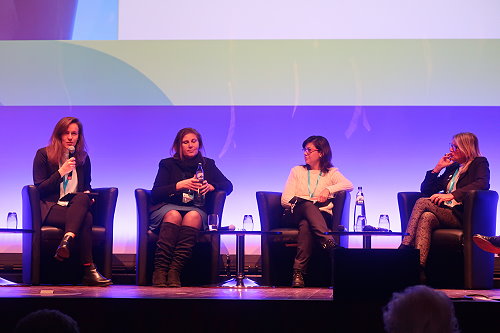 The different presenters highlighted a wide range of projects and initiatives operating or intending to operate at widely varying scales, expecting to work on basin-wide issues to highly local ones or promoting even single products as solutions to wider challenges.
The different presenters highlighted a wide range of projects and initiatives operating or intending to operate at widely varying scales, expecting to work on basin-wide issues to highly local ones or promoting even single products as solutions to wider challenges.
The diversity was great though all presenters seized the opportunity to showcase their specific projects and initiatives in pursuit of the mission. The tight schedule left no time for detailed explanations or questions from the audience.
That made the breaks particularly valuable for discussions and networking.
Ambitions were usually high, but most speakers also acknowledged that without greater involvement of citizens and their organisations the goals might be difficult to achieve. Hardly any voices spoke to what types of activities or production or marketing processes concretely needed to change to achieve ocean restoration by 2030. What needs to change was not so much the focus as putting forward new ideas in the expectation that they will be taken up once the proof of principle is delivered.
The mission management will have to monitor deliveries and obstacles on the way so as to point to new initiatives that need to be taken as a result.
Spyros Kouvelis, member of the mission board reminded the audience that while the ocean economy was estimated by the OECD as about equal to that of Canada and expected to double by 2030, the level of investment represented only about 4% of the $40 trillion under management. While this represents an improvement for acting on Sustainable Development Goal 14 three years ago, a lot more needed to be done in established sectors such as fisheries, aquaculture, tourism, coastal infrastructure etc, but also in newer areas such as emerging energy and biotechnology.
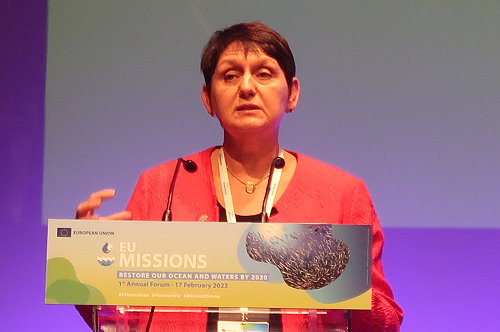 He concluded with cautioning that inmidst the enthusiasm for new investments and new big projects and initiatives, attention for social justice must not be sacrificed if the restoratoin and sustainability objectives are to be met.
He concluded with cautioning that inmidst the enthusiasm for new investments and new big projects and initiatives, attention for social justice must not be sacrificed if the restoratoin and sustainability objectives are to be met.
Sheila Heymans, Executive Director of the European Marine Board also signalled awareness that the interface between science and politics was not only made of information about research results. Citizen engagement and citizen science had to be part and parcel of the restoration mission.
That was also echoed by the panel of speakers and by the closing remarks of Pascal Lamy, Chair of the Board for the Mission 'Restore our Ocean and Waters'.
It's early days for a huge task that truly needs all hands on deck. The programme with all speakers is here.








